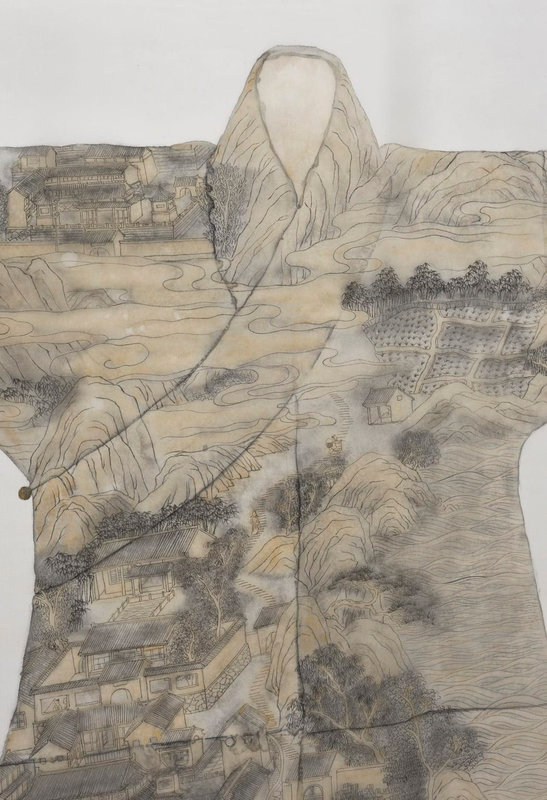Peng Wei (Chinese, born 1974). Landscape of Mount Putuo, 2007
Peng Wei (Chinese, born 1974). Landscape of Mount Putuo, 2007. Ink and colors on silk, 57 7/8 x 82 11/16 in. (147 x 210 cm). Brooklyn Museum, Gift of Mrs. Roscoe C.E. Brown, Dr. Martin E. Frankel, Mr. and Mrs. Maxime L. Hermanos, and Chi Tiew-lui, by exchange, 2014.55. © Peng Wei.
Peng Wei has painted a ghostly image of a Buddhist pilgrimage site within the unconventional frame of an ancient robe of an elite Han Chinese woman. The painting, swept with images both religious and secular, visually transports us on a spiritual journey toward the precarious peaks of the sacred mountain. Peng’s painting reveals not only her engagement with the female body as a site where representations of identity are inscribed but also her sense of nostalgia toward China’s collective history, in light of the impact of globalization upon its cultural heritage.
Mount Putuo is located on an island southeast of Shanghai, in Zhejiang province. It is one of four sacred mountains in Chinese Buddhism and is strongly associated with Guanyin, the bodhisattva of compassion, one of the most popular deities. Beginning about the twelfth century in China, Guanyin was depicted as female, unlike the earlier South Asian male prototype of the deity. As a female bodhisattva, Guanyin gained additional powers: relieving suffering, granting children, and acting as a patron of mothers and seafarers.

/https%3A%2F%2Fprofilepics.canalblog.com%2Fprofilepics%2F1%2F0%2F100183.jpg)
/https%3A%2F%2Fstorage.canalblog.com%2F03%2F02%2F119589%2F96711876_o.jpg)
/https%3A%2F%2Fstorage.canalblog.com%2F11%2F31%2F119589%2F94773502_o.jpg)
/https%3A%2F%2Fstorage.canalblog.com%2F20%2F83%2F119589%2F94772815_o.jpg)
/https%3A%2F%2Fstorage.canalblog.com%2F26%2F72%2F119589%2F75604929_o.jpg)
/https%3A%2F%2Fstorage.canalblog.com%2F59%2F60%2F119589%2F26458628_o.jpg)











/image%2F1371349%2F20240418%2Fob_ac5c4c_telechargement.jpg)
/image%2F1371349%2F20240418%2Fob_709b64_304-1.jpg)
/image%2F1371349%2F20240418%2Fob_22f67e_303-1.jpg)
/image%2F1371349%2F20240417%2Fob_9708e8_telechargement.jpg)